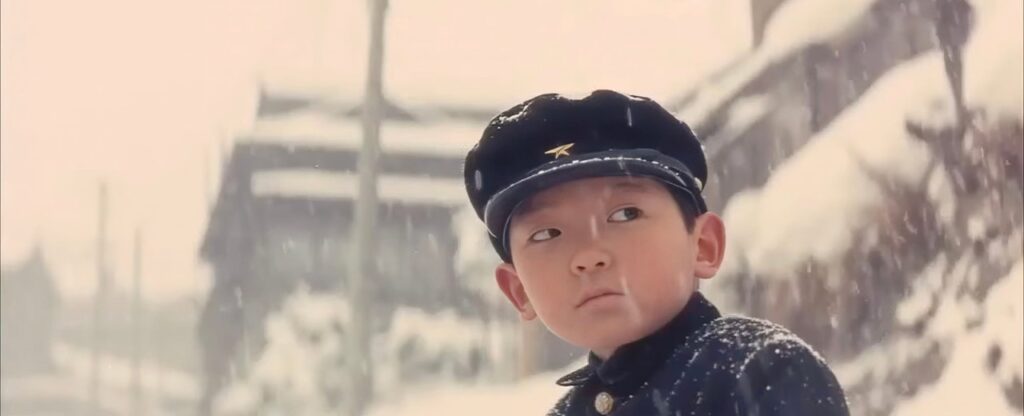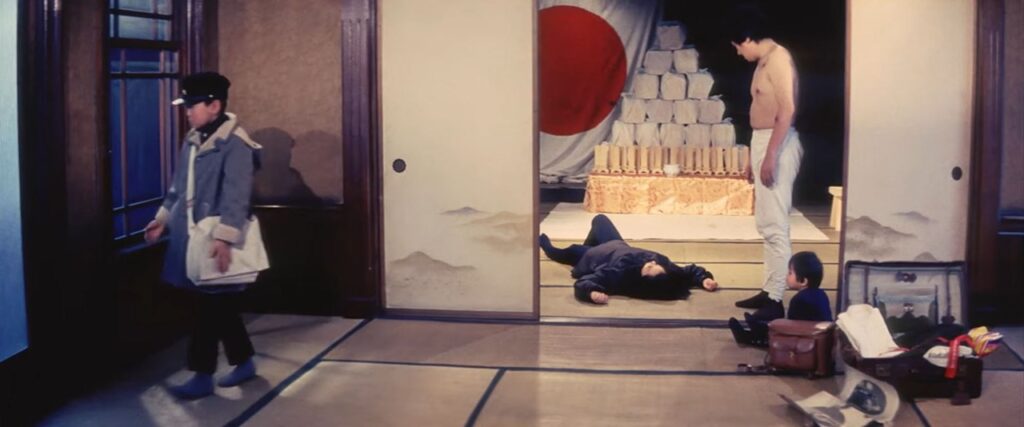| Terry Serres |

The Bleak Humanism of Ōshima’s Boy (1969). Image source.
Boy plays on glorious 35mm at the Trylon Cinema from Friday, August 22nd, through Sunday, August 24th. For tickets, showtimes, and other series information, visit trylon.org.
The 1969 film Boy (Shōnen) by Nagisa Ōshima is something of a minor masterpiece, a work that is undeniably moving but still hard to crack, as inscrutable as its young protagonist’s impassive gaze.
The boy in question is Toshio Omura, played by Tetsuo Abe. He is the son of Takeo and stepson of Takeko. (The characters’ names, as far as I can tell, are first mentioned during some late-story exposition. So for the purposes of this essay, I’ll just refer to them as boy, father, and mother.) The boy has a baby brother they call Peewee, the son of Takeo and Takeko. The parents make their living through a routine of scams where the mother fakes being struck by motorists in order to extort “out-of-court settlements.” The father Takeo is the “mastermind” of this enterprise, while his abused wife is the one taking the fall so to speak. He is played by Fumio Watanabe as one of the shadiest dirtbags in all of cinema: he is a veteran who claims his injuries have incapacitated him for carrying out the scams himself, let alone finding a real job; he also uses his war experience to minimize the risks undertaken by his wife and son. The wife Takeko is played by Akiko Koyama as a creature in constant torment as the middleman in a cycle of abuse.
The boy is often a sidekick in the mother’s scams, typically rushing to her side when she is injured. The mother, indisposed one day (perhaps because she is pregnant with another child), literally pushes her son into the line of duty. The boy takes on his new role in the scheme almost as a matter of course, an inevitability. The wife isn’t really out of harm’s way in this new arrangement, since the father’s shtick in this charade is to slap his wife hard for her negligence as soon as he arrives on the scene, but it’s a case of the-devil-you-know.
Two recent standouts in Asian cinema occur as thematic points of reference for Boy: 2018’s Shoplifters by Hirokazu Kore-eda and 2019’s Parasite by Bong Joon-Ho, both Palme d’Or winners at Cannes. These latter-day films follow recent trends in dark comedy by bending genre and blending humor with dramatic elements. In stark contrast, Boy isn’t so much dark as downright bleak—humanistic, for sure, but bleak as the snows of Hokkaido. Still, as social commentary, Boy packs no fewer punches than either of its acerbic but rollicking successors. Another point of reference is Truffaut’s masterpiece from a decade prior, The 400 Blows, and both are early exemplars of their respective nations’ New Wave movements. Here again, however, the tonal differences are distinct, Ōshima’s stern tale offering little of the Frenchman’s lyricism.
The events proceed largely from the boy’s perspective, although the filmmaker’s point of view remains grimly objective and as sympathetic as possible to the family unit. The most elusive aspect of Boy is possibly its most powerful: Ōshima deploys arresting narrative, visual, and fantastical devices that seem to promise more keys to the character of the boy than they deliver. There are three passages shot in black and white—or, rather, in a saturated deep-blue monochrome. These shifts initially suggest—to this viewer at least—a parallel path of what-if scenarios, more hopeful but only faintly so, spun by the boy. The first example, showing an early attempt at a con thwarted when the driver reacts before impact and sharply scolds the boy, ends with an abrupt shift back to full-color reality. The second example is when the boy runs away one night—and the shift back to color in the nocturnal setting is almost imperceptible; but the next scene, in bright daylight as the family plots its next moves, brings no mention the boy’s disappearance and we are left wondering if it actually occurred. Yet the use of this device to hint at irreality is not consistent. Most prominently, the detour to the northern island of Hokkaido is an actual episode in the film (the boy’s voice-over emphasizes this) but mostly rendered in this deep-blue palette—more than anything, it would seem, evocative of the wintry landscape. Sometimes too, there is an eerie chime-like flourish in the chamber score that again suggests to my ears a departure from reality, but this device proves inconsistent as well. Other devices prove just as elusive in pinning down the boy and his experience of the world: in particular, his occasional narrative voice-overs … and his frequent fantasies about the aliens from the Andromeda Nebula, with whom he identifies, the cosmic messengers of justice who will arrive to kill the evildoers threatening to destroy humanity. These apostrophes to unseen forces are poetic in their childish way, and even reassuring as evidence of a child’s spirit still thriving in this boy forced to grow up too fast and usually acting as the adult in the room out of necessity. But, as with the other devices, they lack a discernible or reliable pattern in the course of events. After struggling with this lack of pattern over three watches, I came to recognize that this is the point. The blur between fantasy and reality is the very stuff of memory … between what-ifs and actual events, between flashes of hope and pangs of longing, between ambitions and disappointments. In Ōshima’s storytelling, neither side of these dichotomies can lay claim to a specific device or mode of presentation. For these are not dichotomies but continuums. The mixing of devices is the point, and it’s the heart of the film’s poetic humanism.
Tetsuo Abe, in his only film role, gives a tightly calibrated performance as the boy. His face remains impassive, his gait stiff and measured. It’s a daily performance of stoicism, almost a wall erected between his tumultuous home life in a family to which he owes his love (or at least his loyalty) and the uncaring world surrounding them. His expression is impossible to read: is it deadened to the relentless heartbreak of his existence, or deadpan against the absurdity of it all? At one point, provoked by his insecure mother to divulge his feelings about her, he states plainly: “I don’t feel or think anything.” This comes less as a direct answer than as a generic confession. So restrained and resolute is the boy’s movement through the world that the rare breaks in his affect command our attention and concern.
Despite the constraints of his circumstances, this is a boy who makes his own way and nowhere is this more evident than in the moral dimension. He is being groomed as a criminal but can in no way be described as lawless. In an early voice-over he confesses that the hardest part of his job is lying to the doctors who care for him; and as his incidental injuries accumulate he expresses relief at no longer having to lie. Yet, at the end of the film when the law finally catches up with his family’s career of fraud, out of loyalty to his parents he lies to the authorities without any pang of conscience. The boy consistently acts out of empathy—toward a boy he witnesses being bullied in an alleyway (who bullies the boy in return), toward his beleaguered mother, and above all toward his baby brother Peewee. It is the boy’s responsibility to this burbling infant, indeed, that rules out any hope of the boy’s escape … yet the boy never treats the baby with resentment. He mentors the child, teaching him words, sharing stories and even his cherished fantasies. And those fantasies are key: it becomes evident that the aliens from the Andromeda Nebula, these “messengers of justice” are in fact the only moral compass available to the boy.

Appearances of the Japanese flag throughout the film are never incidental. The Boy, as often, is pushed to the side of the frame
Japanese society as depicted in Boy is as oppressive and depressing as the boy’s own circumstances. This is an impersonal and bureaucratic world, cold and uncaring. Aside from meals, dress, and day-to-day life are shown as Westernized, with depictions of traditional Japanese ways largely absent. With the possible exception of a scene involving two geishas singing regional folksongs at a sushi restaurant, almost every encounter observed outside the family nucleus is minimal to the point of brusqueness and chiefly transactional. Ōshima’s harsh view of Japan is evident in his ironic, even embittered use of the Japanese flag throughout the film—pay attention, you’ll see the flag often, and it never seems incidental. Right out of the gate, during the opening credits, we get a circle against a white field—resembling the design of the Japanese flag but the circle is black not red, with what appear to be red kanji bleeding out the circle’s edge (the kanji’s meaning, if any, is not subtitled). The father takes the Japanese flag out when the family is working its scams as though representing the “economic miracle” of post-war Japan. The most unnerving appearance of the flag occurs at the end of a scene in a hotel where the family is flopping: the father has exploded in a fit of post-traumatic violence, the scene shot in the deep-blue hue. When the rage subsides, the director shifts to full color and pans out to show the Japanese flag covering the entirety of the wall behind them. The trenchant references to Japanese nationalism extend, visually, to the director’s repeated use of red objects on white backgrounds throughout the film. The mother is frequently shown wearing red in a varied wardrobe of dresses, sweaters, and coats. We have blood against a pale face and blood against snow. The most telling example is of a red boot, with tragic significance in the story, found in the snow. Later on, there is a heartbreaking scene where the boy places this boot on a pyramidal “snowman” he has constructed, something of an effigy of the aliens he hopes to join. Realizing at last that his hopes of deliverance are illusory, he erupts in desperate rage and destroys the snowman. Clearly, a dramatization of the director’s own dissatisfaction with the direction of post-war reconstruction.

Mimicking the Japanese flag, this red boot against a pyramid made of snow is full of symbolic significance in the context of the film.
Edited by Olga Tchepikova-Treon
